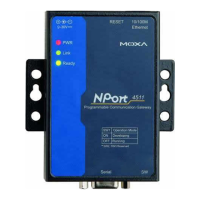MGate MB3000 User’s Manual Configuring the Modbus Gateway
Slave ID Map Example
Suppose you have two ASCII slave devices on port 1 assigned to slave IDs 3 and 5. The MGate will
automatically create a virtual ID range for port 1, which you will need to modify. If slave IDs 3 and
5 are already in use by TCP slaves, the virtual ID range should be set to IDs that are not in use, such
as 20 through 22. In that case, you would specify a slave ID offset of -17, since that is the difference
between the virtual ID range and the actual slave IDs. The formula is as follows:
With the slave ID map configured, a master that wants information from one of the ASCII slaves
would address the request to slave ID 20 or 22. The MGate would identify that the request was
addressed to a virtual slave ID in the slave ID map. The MGate would then forward the request to
port 1, applying the -17 offset to obtain the actual ID of the desired device.
Customize Modbus Settings
The Modbus tab is where certain adjustments can be made to fine tune the communication between
different Modbus networks. You can configure Initial Delay, Modbus TCP Exception, Slave
Channel, and Response Time-out.
Initial Delay
Some Modbus slaves may take more time to boot up than other devices. For certain environments,
this may cause the entire system to suffer from repeated exceptions during the initial boot-up. You
can force the MGate to wait after booting up before sending the first request with the “Initial
Delay” setting.
Modbus TCP Exception
The MGate MB3000 is a protocol gateway that transparently passes requests and responses between
the Ethernet and serial interfaces. In some situations, it may be necessary for the gateway to return an
exception in response to a request from a Modbus TCP master. This is enabled or disabled with the
“Modbus TCP Exception” setting. When enabled, the unit can return two types of exception:
Timeout
There is no response from the slave. Maybe the device is off-line
or the serial cable is broken.
Request dropped
There are two situations that will result in this exception:
The request queue is full (32 request queue for each master)
The destination ID not included in the slave ID map.
Not all Modbus TCP masters require this exception, so it is up to you to determine if this setting
should be enabled.

